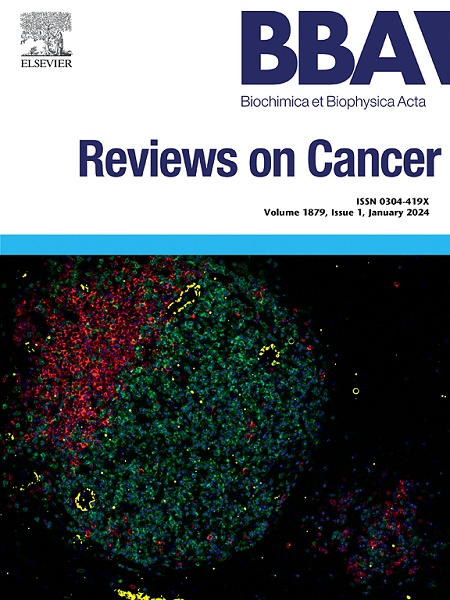New advances in the therapeutic strategy of head and neck squamous cell carcinoma: A review of latest therapies and cutting-edge research
IF 9.7
1区 医学
Q1 BIOCHEMISTRY & MOLECULAR BIOLOGY
Biochimica et biophysica acta. Reviews on cancer
Pub Date : 2025-02-01
DOI:10.1016/j.bbcan.2024.189230
引用次数: 0
Abstract
Head and neck squamous cell carcinoma (HNSCC) is a common and aggressive malignancy with a poor prognosis, particularly when diagnosed at advanced stages. Despite progress in surgical, chemotherapeutic, and radiotherapeutic interventions, the five-year survival rate remains low due to high rates of recurrence and therapeutic resistance. This review explores recent advances in therapeutic strategies for HNSCC, focusing on targeted therapies, immunotherapy, and innovative drug delivery systems.
Targeted therapies, such as EGFR inhibitors and PI3K/AKT/mTOR pathway inhibitors, offer promising options for overcoming HNSCC, though resistance challenges persist. Emerging treatments, including dual-target inhibitors and personalized therapeutic approaches, show potential in addressing these limitations. Immunotherapy, particularly PD-1/PD-L1 blockade, has achieved positive outcomes in a subset of patients, though overall response rates remain modest. Strategies aimed at enhancing immune responses, such as combination therapies and nanotechnology-based drug delivery systems, are actively being investigated to improve efficacy. This review also underscores the critical role of the tumor microenvironment and epithelial-mesenchymal transition (EMT) in HNSCC progression and therapeutic resistance. Novel approaches, including smart drug delivery systems utilizing nanotechnology and immune modulation, are opening new avenues for more personalized and effective treatments. Ongoing interdisciplinary research into molecular targets and advanced drug delivery techniques holds great promise for significantly improving patient outcomes in HNSCC.
头颈部鳞状细胞癌治疗策略的新进展:最新治疗方法和前沿研究综述。
头颈部鳞状细胞癌(HNSCC)是一种常见的侵袭性恶性肿瘤,预后较差,尤其是在晚期诊断时。尽管在手术、化疗和放疗干预方面取得了进展,但由于高复发率和治疗耐药性,5年生存率仍然很低。本文综述了HNSCC治疗策略的最新进展,重点是靶向治疗、免疫治疗和创新药物输送系统。靶向治疗,如EGFR抑制剂和PI3K/AKT/mTOR通路抑制剂,为克服HNSCC提供了有希望的选择,尽管耐药性挑战仍然存在。新兴的治疗方法,包括双靶点抑制剂和个性化治疗方法,显示出解决这些限制的潜力。免疫治疗,特别是PD-1/PD-L1阻断,在一部分患者中取得了积极的结果,尽管总体反应率仍然不高。目前正在积极研究旨在增强免疫反应的策略,如联合疗法和基于纳米技术的药物输送系统,以提高疗效。本综述还强调了肿瘤微环境和上皮-间质转化(EMT)在HNSCC进展和治疗耐药中的关键作用。新的方法,包括利用纳米技术和免疫调节的智能给药系统,正在为更个性化和更有效的治疗开辟新的途径。正在进行的分子靶点和先进给药技术的跨学科研究为显著改善HNSCC患者的预后提供了巨大的希望。
本文章由计算机程序翻译,如有差异,请以英文原文为准。
求助全文
约1分钟内获得全文
求助全文
来源期刊

Biochimica et biophysica acta. Reviews on cancer
医学-生化与分子生物学
CiteScore
17.20
自引率
0.00%
发文量
138
审稿时长
33 days
期刊介绍:
Biochimica et Biophysica Acta (BBA) - Reviews on Cancer encompasses the entirety of cancer biology and biochemistry, emphasizing oncogenes and tumor suppressor genes, growth-related cell cycle control signaling, carcinogenesis mechanisms, cell transformation, immunologic control mechanisms, genetics of human (mammalian) cancer, control of cell proliferation, genetic and molecular control of organismic development, rational anti-tumor drug design. It publishes mini-reviews and full reviews.
 求助内容:
求助内容: 应助结果提醒方式:
应助结果提醒方式:


